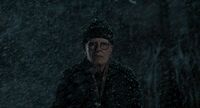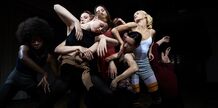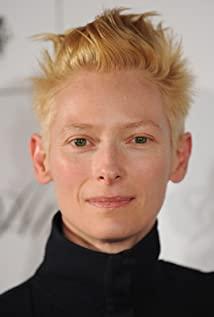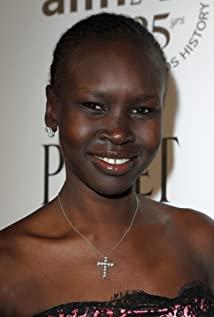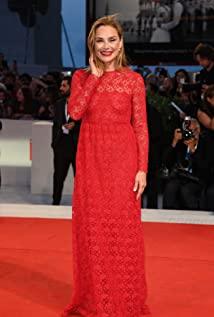I saw a new term to describe the new version of [Yin Feng Zhan Zhen] , some people call it "sensory horror film" .
In the pale green Ohio countryside and the deserted Berlin of 1977, the new version of [Yin Feng Zhan Zhen] did not repeat the splash-ink painting of colors in the original version.
In the original version of 1977, Dario Aquido used his usual "lead aesthetics" to keep the horror film full of colorful colors and mysterious conspiracies in the history of filming.
The director Luca Guadagnino who has filmed [Please call me by your name] has his own aesthetics under the remake, in a gentle and intense way.
The colors have become milder, but the body and dance parts are more intense.
In the movie, the dance teacher played by Tilda Swinton said: Dance is neither beautiful nor pleasant.
The dance school here is a lair for witches who hide mysteries and nightmares, and innocent dancer girls use dance to construct a witchcraft ritual in the unconscious .
On one side is the dancer who dances wildly, and behind the mirror on the other side is the girl who was smashed to pieces with the dance moves and wanted to escape.
The punishment for resistance and betrayal is achieved through dance.
The last sacrificial dance before the end of the movie is a visual adventure of a flurry of demons. The dancers are naked, dancing like a Bacchus in blood red, brutal and hard-core, using their bodies to add to the witch’s Sabbath. Some dizzying shocks.
Film critic Zeba Blay wrote:
I was a bit scared by the last scene, which reminded me of Carolee Schneemann's "Meat Joy", which is an ecstatic carnival, people are in a sea of raw meat, fish and meat. Tumble and play.
Sneeman is a legend in the feminist art movement of the 1960s and 1970s, just like the body carnival in "Meat Joy" , she likes to use the female body to express gender power.
Guadagnino's reference and tribute to feminist art throughout the film are also based on the highly exploratory use of the body and senses.
The modern dance in the film was inspired by the German female dancer Mary Wigman, and then elaborately choreographed by the modern dance finger Damien Jarlay.
Guadagnino showed us a possibility. He explored the history, memory and emotions of 1977, and allowed witches to dance in the world of feminist artistic imagery.
This is a movie about the world of women. I think we really want to be immersed in the femininity of this movie. I hope that this male-directed film can showcase female artistic experience in an intense way.
In the interview, the director mentioned more than once that this is a female film, and directly mentioned the inspiration and influence of feminist body art in the 1960s and 1970s on him and the film.
The female artist Ana Mendieta (Ana Mendieta), Gina Paine (Gina Pane), who's name must be an inspiration on the list.
Even in July last year, Anna Mendieta’s heritage organization filed a complaint against Amazon, the producer of the film, to court.
Because there are some very obvious "excessive references", such as the reshaping of Anna's two titles called "Siluetas" and "Untitled: Rape Scene" (Untitled: Rape Scene) in the movie.
The final result was that the two parties reached a settlement. The final version of the film included these two deleted photos.
They should have appeared in the heroine's dreams. When the dreams were controlled by the witches at the dance school, these images collected from female artists in the 1970s flashed past the camera in rapid succession.
Although there are still controversies, it cannot be denied that the inspiration that Guadagnino "stolen" from these works of female bodies is already an important part of the femininity of the film.
Anna Mendieta , many people are not familiar with her name, but a selfie of her with a beard is widely circulated, and it is even imitated by many celebrities.
This is an influential Cuban-American performance artist, sculptor, and painter in the 1970s. Her works often start from the female body, even her own body.
For example, her earliest and most famous performance art in "Untitled: Rape Scene".
In 1973, 25-year-old Anna was still studying for a master's degree at the University of Iowa. In March of this year, a bad female student was raped and killed in the college.
This incident has been difficult for her to relieve herself, so she performed a major performance that was also the beginning of her career.
She invited students from the same class to come to her apartment. At the agreed time, what everyone saw after coming was this:
Anna turned her back to the door, leaned down and half-prone in front of the table, her head and arms were tied with a rope, and her naked lower body was covered with blood (actually chicken blood).
This action lasted for an hour. This is a rewrite of the picture of her female classmate being brutally raped and murdered.
Professor and art historian Kaira Cabanas wrote:
Her body is the subject and object of this work, and her physical existence requires the recognition of female subjects.
This is also the source of the "Untitled: Rape Scene" in the movie, and the other "Outline" is from Anna's most iconic "Earth Body" series.
During the seven years from 1973 to 1980, Anna returned to Cuba, Mexico and other places to explore different terrains to create.
She imprinted the outline of her body in the snow, on the grass, in the river, and in the tomb. The soil, rocks, flowers, branches, and even torches and snowflakes were placed around the outline of her body.
In this way, she talks to the whole world, the universe, and herself when she was a child.
she says:
I have been engaged in a dialogue between the landscape and the female body. My art is a way of rebuilding the bond with the universe. This is a return to Mother Earth.
What's interesting is that the concept that Guadagnino has always emphasized is "mother" . The goddess of sighs (Mater Suspiriorum) that finally appears in the film is one of the three goddesses of the witch myth.
In the movie, there is a text on the wall of a room that reads "Mother can replace anyone, but no one can replace it . "
Anna's land art is the root of Latin America that she has been pursuing in her own blood. It is her performance art that integrates the mother elements of Latin American religions.
At the same time, she was one of many female artists in the 1970s. The 1970s was a period when the western feminist art movement was booming.
They try emerging land art, body art, and performance art, exploring the themes of women, identity, violence, death and life in body art.
The same goes for the dance and body in [Yinfeng gusts]. They use their bodies to guide violence and power, witchcraft and terror.
In addition to Anna Mendieta, we can also see Gina Pane and Claude Cahun in the movie.
Both are French feminist artists, and Gina was a member of the body art movement in the 1970s.
Her famous performance art work "Wound Theory" uses a razor blade to cut balanced wounds on the arms and face, and complete the body ritual with self-abuse.
The performance art of "Death Control" is that she lay on the floor, letting maggots crawl all over her cheeks, in this way to express every step close to death.
Regardless of the controversy, no matter what works Guadagnino has borrowed, the film explores the world from the female body, and it is full of sensory impact.
It is fortunate enough for the audience to see such an excellent horror film mixed with female artistic imagery.
-
Author/curl
This article was first published on WeChat public account [Pocier]
View more about Suspiria reviews




